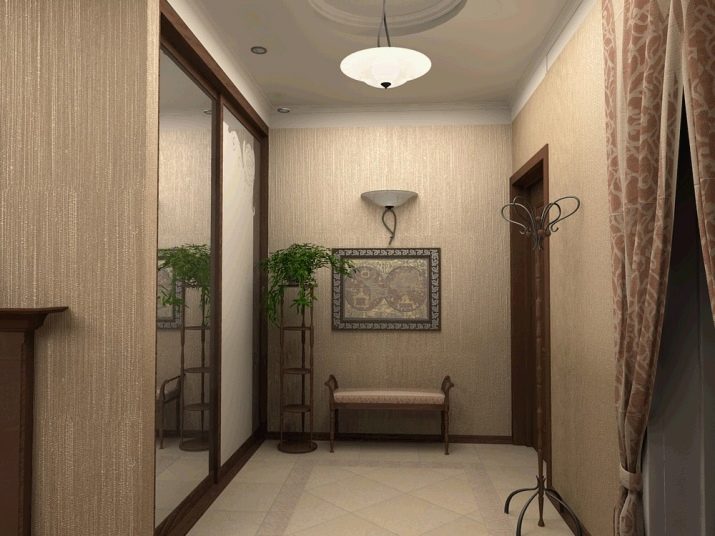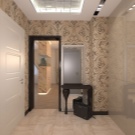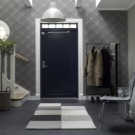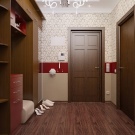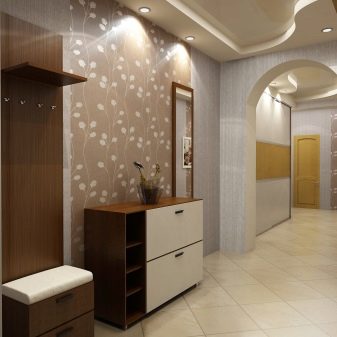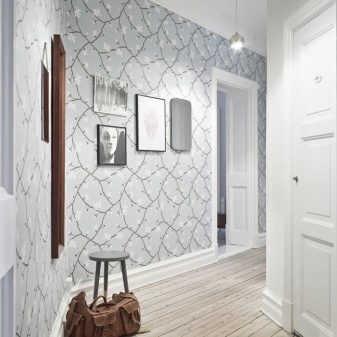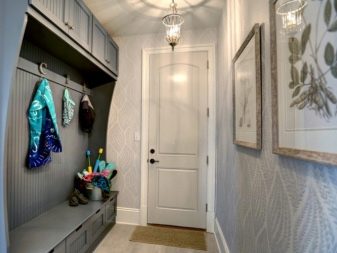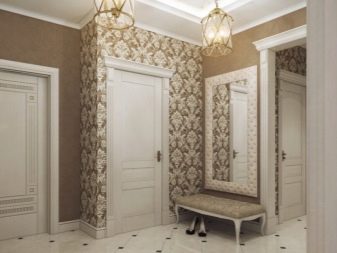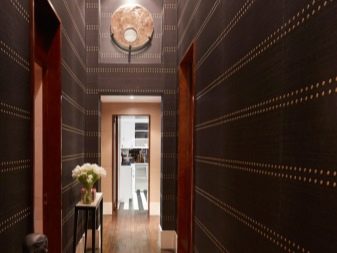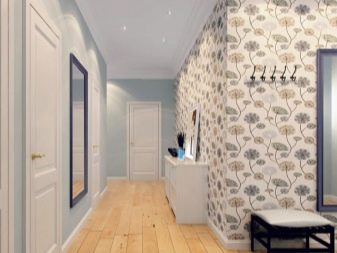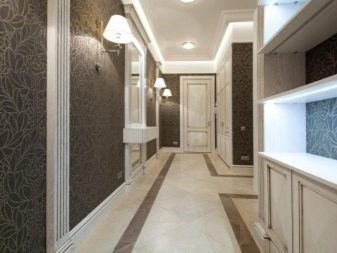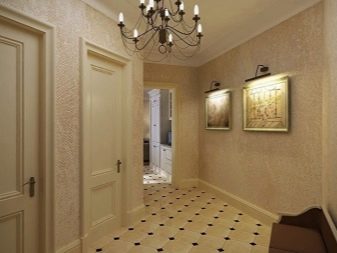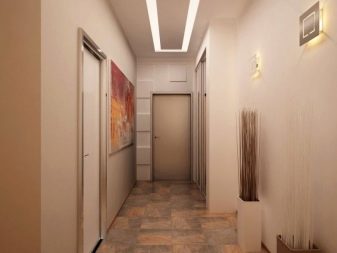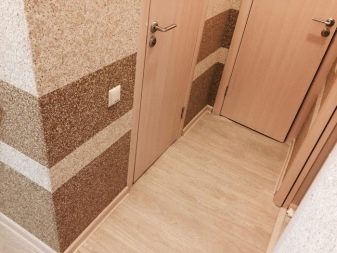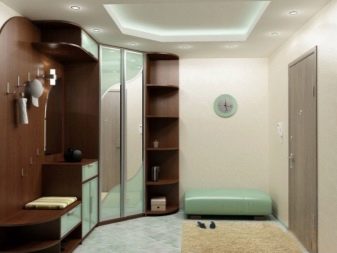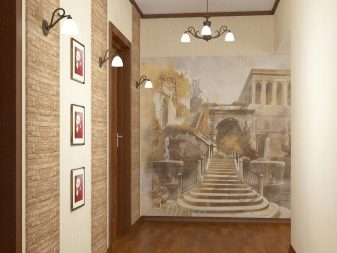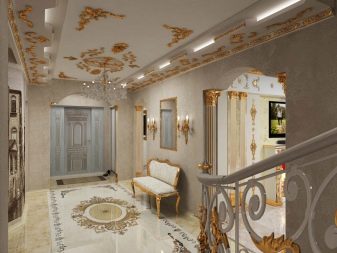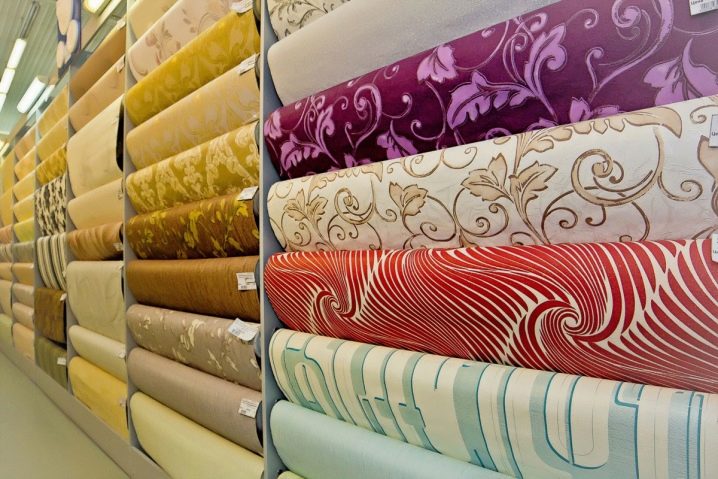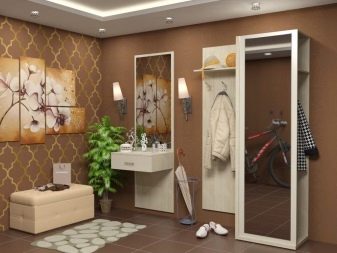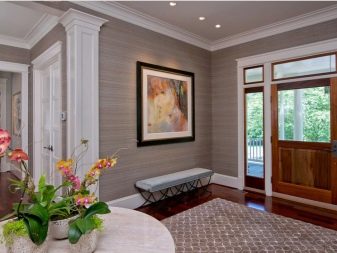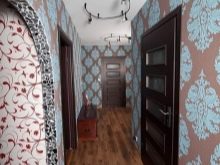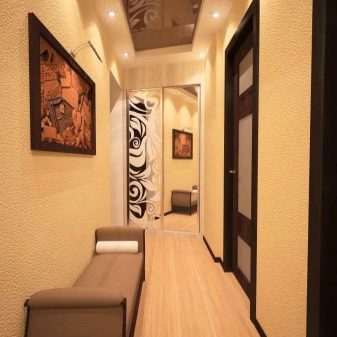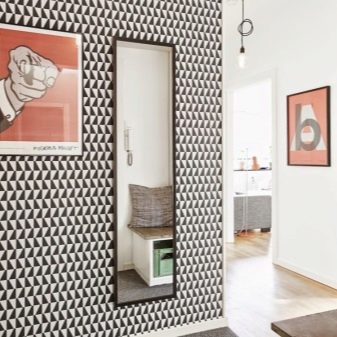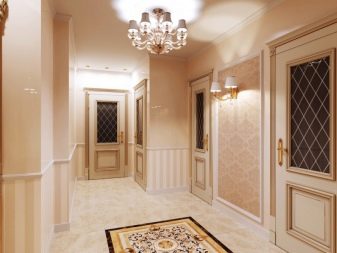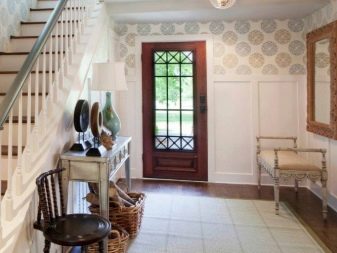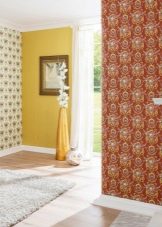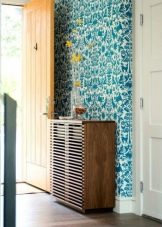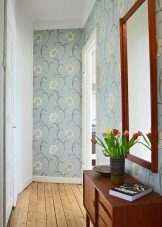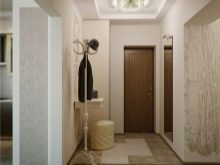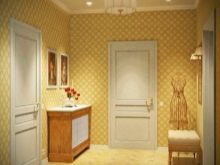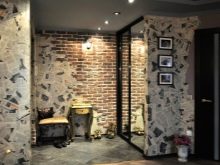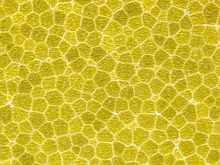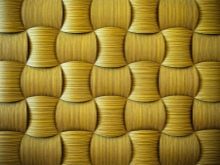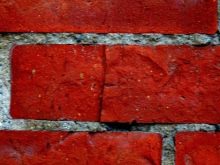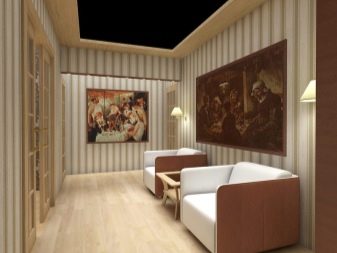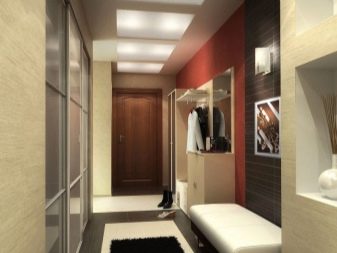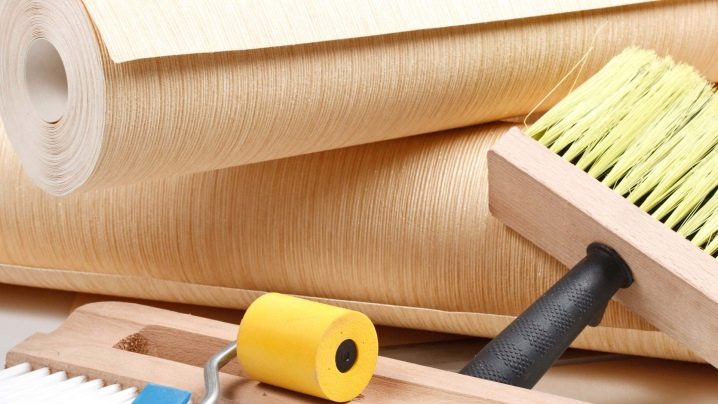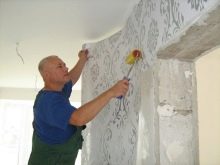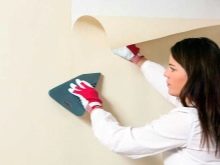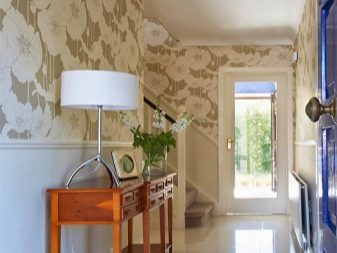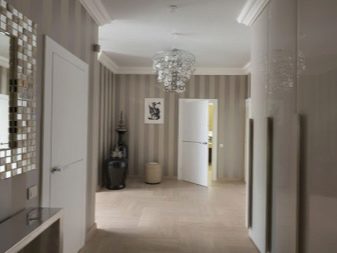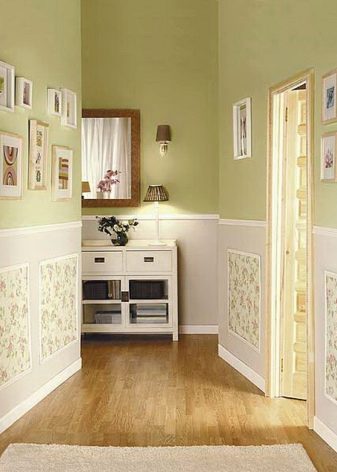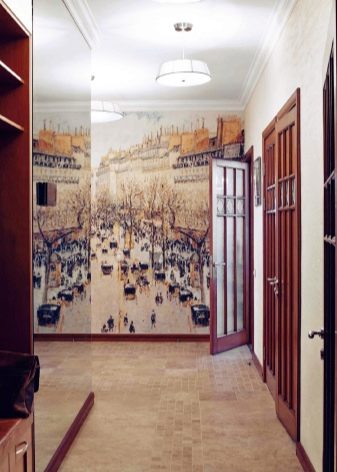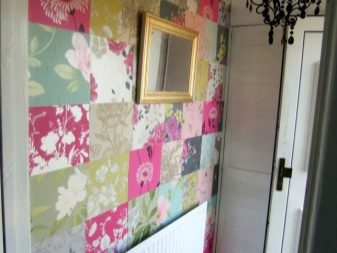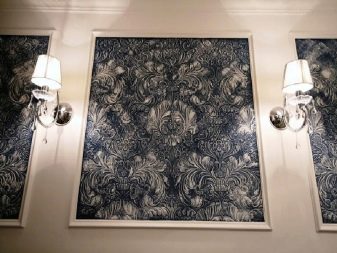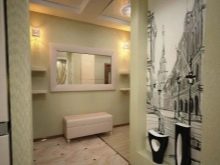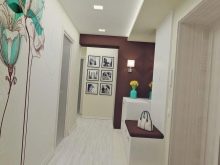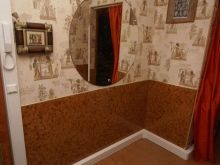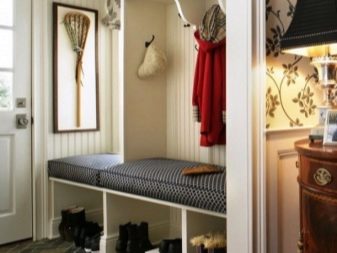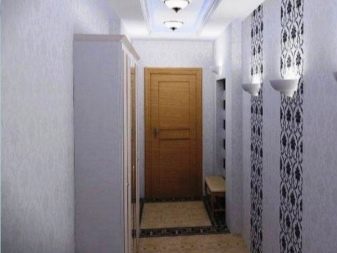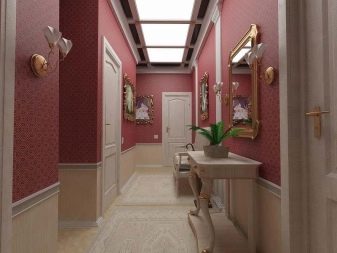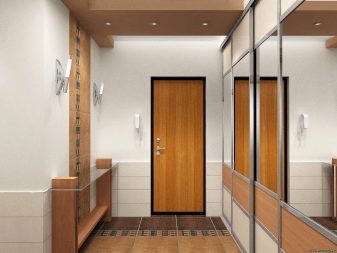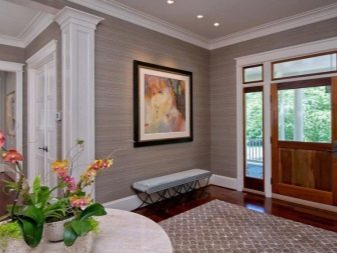The choice of wallpaper for the hallway and corridor
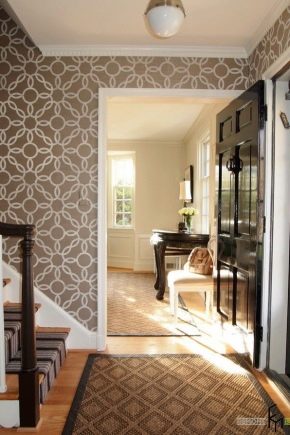
There should be no imperfections in the interior of the dwelling: it is important to take care of every room, including the hallway and the corridor. Great importance in the decoration of these rooms have wallpapers. As one of the key design elements, they make walls well-kept and tidy. The choice of wallpaper for the hallway and corridor is subject to a number of features. Before buying it is worth exploring the types, fashionable shades, colors, pattern combinations, texture and other nuances.
Materials
Wall-paper is a wall and ceiling finishing material of a different type. This finish is internal. Wallpapers are sold mainly in the form of roll products, although, thanks to modern production technologies, another kind of material packaged in bags is offered to the attention of buyers.
It is the type of wallpaper that is the factor that determines the method of pasting the surface of the walls: they are glued in the form of cuts of the desired length or spread with a spatula.
The production uses a variety of raw materials, which determines the quality and performance characteristics of each type of wallpaper.
The most common materials are paper, textiles and vinyl. Today, this facing is much more interesting than Soviet-era products: modern manufacturing companies offer a wide range of goods, which is often the focus of the premises.
If earlier it was believed that the wallpaper for the hallway and the corridor did not have special significance, today the opinion has changed radically: this facing contributes to determining the status of home owners, it indicates their taste preferences and determines aesthetic perception.
Species
The choice of material is based on the knowledge of varieties. There are many of them, however, not all raw materials are suitable for a hallway or a narrow corridor. And the matter is not at all in color: the texture and design do not fit, which either reduce the space of the already small rooms, or overly glow, or create a feeling of heaviness. In addition, some varieties do not fit in style.
The most popular varieties of decoration, which is appropriate in almost every style of interior composition, are wallpapers: paper, vinyl, non-woven, textile, for painting, liquid, glass wallpaper, natural, 3D.
Roll products differ in different widths, which is very convenient and allows you to glue the walls as accurately as possible, without bubbles and folds.
- Paper wallpaper - low-priced canvases with a paper base and printed on it or photo printing. They differ in thickness, can be quite thin and are divided into two categories: simplex (single-layer) and duplex (two-layer). The first ones are simpler, cheaper and more difficult to glue, the second ones are able to hold out on the walls for more than 5 years, without requiring glueing. These canvases are afraid of moisture, so when in contact with water they can move away from the walls.
- Vinyl analogues have a porous surface structure. Unlike paper canvases, they consist of two layers: a vinyl top and a non-woven substrate. In some products, the basis of paper. This finish is expensive, although it does not justify its price, because after some time it releases formaldehyde fumes into the air.Vivid representatives of the variety are silk-screened wallpapers - smooth, solid and foamed canvases, the coloring of which is embossed, from which the canvases look like cloth.
- Flizelinovye wallpaper resemble vinyl. They are quite dense, made of polymers or textile fibers. These canvases have breathability, they are refractory, resistant to ultraviolet radiation, so fit in the hallway, sun-drenched. The texture is pleasant because it hides small irregularities of the walls, which is a significant advantage. However, non-woven coatings accumulate dust on the surface and are characterized by a structure that requires careful handling.
- Textile Wallpaper is like a decorative covering with woven threads pasted on a paper base. The threads can be intertwined or arranged in parallel (as close as possible). This finish is quite controversial. It demonstrates the welfare of the owners of the house, but in pasting it is quite whimsical and does not allow the slightest glue to hit the surface of the front side. It is difficult to glue it, besides it is necessary to apply the composition only to the wall, which is not always convenient and sufficient for maximum adhesion.
- Wall decoration for painting - wallpaper mostly white color meter width, made on a paper base. The structure of the material is embossed, has a different simple pattern, often similar to chaotic stucco. Due to the unusual relief when painting creates an interesting pattern, while you can hide the irregularities of the wall. The material is attractive because it can be painted many times: the paint falls evenly, painting all the hollows of the relief.
- Liquid wallpaper - a product of the new generation, which is the only one in the line of interior wall finishing that comes in bags and resembles glue-cotton. Moreover, the similarity is not only external: the material is also diluted with warm water and allowed to stand for the right time (about a day), tightly closing the bag. The finished raw material is smeared on the wall: the look of the facing is an original, non-uniform, resembling an uneven mosaic. The uniqueness of the material is the ability to perform any pattern. To do this, after a primer on the wall paint the desired composition, then fill the wall with different shades of wallpaper. The disadvantage of raw materials is the fear of falling on the surface of the water.
- Glass fiber - a kind of material with a fiberglass structure.It is made by a special method, reminiscent of knitting. In the work using glass fiber. To the material acquired a stable form, it is treated with special impregnations. Glass fiber is an original solution to the design of the hallway or corridor, they are not subject to rotting, are acceptable, do not contain harmful toxins, and allow painting.
- 3D Effect Cladding - version with three-dimensional (three-dimensional) image. Canvas with visual distortion can change the amount of space, therefore, is the appropriate type of finish. 3D wallpapers have a dense, resistant to random mechanical damage structure. They do not burn and perfectly fall on the walls without forming bubbles. However, with a lot of advantages, this finish does not always look good on the wall: for the illusion to be harmonious, you need a small print or more space.
- In line natural Wallpaper included products from jute, leaves. In addition to them, bamboo and cork coatings are interesting. Compared to other analogues, these materials are quite expensive, although their quality characteristics are quite high. They are resistant to moisture, look advantageous and expensive, draw the design to the desired level with a premium look and combine with different furnishings.Their distinctive feature is the sand color shade and appearance, which is far from the classic presentation.
What wallpaper to choose?
In a huge choice of wall decoration, it is difficult at first sight to buy what you need. Sometimes around the mass of options that their variegation distract attention from the desired canvas.
In order not to get confused when buying, it is necessary to outline an algorithm:
- view the existing hallway or corridor;
- the choice of shade and pattern, taking into account the area of space and lighting possibilities;
- selection of paintings in the store (several options);
- identifying the pros and cons (glueing method, complexity, resistance to abrasion by mechanical action);
- calculation of the quantity with respect to the pattern;
- purchase based on value for money and premium.
Wallpaper does not buy solely on the basis of appearance. Of course, it should be beautiful and have a pleasant texture. However, this is not enough. Often, at first glance, the canvas seems to be special, and when re-examined it irritates the eyes.
It is worth looking at several types of paintings, given the irregularities of the walls, the thickness of the wallpaper,the relevance of their subject matter in a particular interior composition.
To simplify the selection, it is worth taking note of some useful tips:
- the type of wallpaper should be “correct”: it is important to pay attention to strength, the average thickness of the material, the absence of a porous structure (it breaks off in small pieces under random mechanical action);
- excessively thick and textured canvases are more difficult to veneer; if the walls have irregularities, they can quickly move between the joints;
- the matting and small strip in the interior of the hallway or corridor create wall ripples: such pictures look great close up, but they hit the eyes from afar;
- it's time to forget about standard solutions, today they are commonplace: depending on the pattern, the wallpaper can be combined with paired rolls or glued onto the wall horizontally;
- a large wallpaper print destroys a small space, so it will not work for a narrow corridor or a tiny hallway;
- if the room is narrow, you can stick the paired wallpaper, drawing attention to the edges of the width (on the long sides it is better to choose monochromatic canvases);
- if the space is small, it is better to choose washable wallpaper: this way you can extend the life of the wall covering and it is easier to care for the cleanliness of the walls;
- if in the interior of the hallway or corridor there are plastic panels, as a companion, dense relief wallpapers will suit them: they are better combined with a smooth plastic texture.
It is necessary to pay attention to the subtleties of color combinations. Today, wallpapering on a wall means being a designer. It is not enough to choose a beautiful picture and an interesting basis.
It is important to consider the combination with the furnishings, the depth and saturation of the hue:
- despite practical considerations, the dark shades will create the illusion of reduced space, they will put pressure on the floor;
- you can not buy paintings in the same color with the floor: this creates the feeling that the floor is wrapped on the walls;
- if the hallway or corridor is replete with small items, a large print is excluded: it will create an atmosphere of confusion;
- if you choose a color that is not in the interior of the room, you cannot do without support through design elements (hangers, floor lamp, lamps, rugs);
- if the room has a window, wallpaper in the color of the curtains is excluded (the walls must be different from the curtains).
Colour
The colors of the wallpaper for the hallway and the corridor are multifaceted. No hard frames: delicate taste is important.Some people manage to design using dark shades, and the hallway looks stylish and status. As a basis, you can take the ideas of experienced designers.
Conventionally, all shades are divided into practical and beautiful. The first group includes beige and divorced brown canvas. Of all the shades of the color palette, they most harmoniously fit into the interior of the hallway and corridor. This is a classic, relevant outside the choice of style.
The canvases of the second group are divided into two types: pastel shades and rich colors. The number of muted light colors include lilac, gray-pink, blue, turquoise and delicate peach shades. The bright tones of the palette are soft green, burgundy, wine red colors. The colors look muffled, due to the texture of the paintings look expensive and stylish.
As for the white and yellow shades, their choice is not so popular. White color is a brand, so it is not suitable for rooms with high traffic. Yellow color gives way to beige and milky: so the walls look more premium. Black paint in the interior of the hallway and the corridor is inappropriate. The maximum that they are supposed to - to decorate the elements of the wallpaper pattern (and then in a small amount).
Design
Decoration paintings - a special theme.Each brand seeks to produce something unique that can attract a buyer. In conditions of competition, the canvases are distinguished by a variety of texture and pattern.
The choice of wallpaper must obey two rules:
- practicality;
- beauty
The design takes into account several factors, among which texture is of particular importance.
She may be:
- smooth, thanks to which the drawings have clear and expressive lines (lace and floral motifs, geometric shapes, flowers, striped wallpaper);
- with a relief pattern (including 3D), which allows the paintings to look volumetric (velor wallpaper, embossed);
- with the imitation of the texture of different materials (under the laminate, tile laying, weaving, crocodile skin, tortoise shell, zebra or python skin, with pebbles).
The main condition is relevance: the wallpaper must be in harmony with the general idea of design, match at least in one shade with the existing situation, observe the necessary theme in style.
They should bring in the room notes of positive (warm colors) and home comfort (striking metallic and fluorescent canvases, creating the illusion of a disco, are excluded).In general, the situation should be consistent with the whole style of the apartment.
Sticking selected wallpapers
Wallpapering is simple, but many people have a lot of questions. Some are interested in where to start finishing the walls, others do not know how to glue the canvas correctly. It may seem that each canvas has its own tricks and features of pasting.
In fact, everything is not as difficult as it may seem:
- if the walls were plastered with other wallpaper prior to repair, they should be removed with a spray gun and water (it is easier to remove the old coating, the cloths are removed in large fragments, and there is practically no dust);
- on each roll is indicated the method of gluing (sometimes it has a schematic image);
- thin canvas glue overlap, imposing one on another, dense wallpaper glued close to each other (butt);
- since there is rarely a window in these rooms, the first canvas is glued to the door, then they go clockwise around and return from the back side of the door;
- if the canvas is textured and dense, no matter where to glue it: you can start work from the corner (this way you can arrange the corner as accurately as possible without distortions and folds);
- The method of pasting is influenced by the design options for the location of the wallpaper: if it is a patchwork technique, the cut out fragments will have to be pasted from the middle or according to the applied marking.
Fashion options
Since the wallpaper of the same design is boring, you can decorate the walls of the hallway and the corridor with various techniques of experienced stylists.
The most interesting stylistic solutions are:
- horizontal combination - sticking of the cloths perpendicular to the floor by the method of alternation taking into account the features of the pattern (relevant for the strip);
- vertical alternation - a technique similar to the previous one, but with a slight difference: the pattern is less than a plain canvas (it is better to arrange the center with a print, to begin alternating along the edges, making the solid stripes wider);
- the use of two roughly the same color - accentuation of the walls, unobtrusive contrast, distracting attention from the unsightly corners of the room;
- mix of plain wallpaper and canvases with a pattern (or photo wallpapers) - method of highlighting the accent zone, in which they use different in texture and the same color of the canvas, decorating part of the wall or its entire bright spot by means of a thematic drawing;
- patchwork technique - sticking on the wall of small fragments of different colors and butt-pattern, cut into squares or rectangles (patchwork imitation);
- insert-panel - the creation of a home art gallery, which is carried out by gluing a small fragment on a monochromatic coating, followed by framing into a frame from a baguette or ceiling plinth;
- accentuation of room features - deliberate underlining of protrusions, niches, panels, achieved by highlighting them with contrasting wallpapers;
- space zoning reception - division of the room into separate parts, a way to create a clear organization, the appearance of order;
- way with panels - an original solution of the interior composition, in which the wallpaper is glued by alternating, zoning or highlighting the design features (glued to the wall or the panels themselves).
Beautiful photos of the hallway interior
Hallway or corridor, "dressed" in different textured wallpaper, look elegant and comfortable. The uniqueness of the wallpaper lies in the fact that they are perfectly combined with white walls.
Color and soft contrasts can provide a unique effect:
- the hallway and the corridor can be decorated with different wallpapers, combining stripes and vegetable laces in beige shades: an excellent solution to the zoning of the combined rooms with the combination of wallpaper and panels;
- the light of the hallway can be designed with the help of paired wallpaper with lace patterns: due to the interesting texture, the walls do not look boring, and the black contrast accent will divert attention from the wall protrusion, reducing the usable area;
- You can make a royal design by combining textured wallpaper of terracotta color with beige panels: adding paintings and a mirror with gold to the interior and supporting the idea with wall lamps with gold trim, you can emphasize a special status;
- an original reception of the contrast of beige wallpaper with embossing and a photoprint with a forest theme in the form of a door will allow space and warmth in the space, filling the room with a special atmosphere;
- lovers of sophisticated techniques are sure to enjoy the interior composition, which combines horizontal and vertical lines: you can accentuate part of the wall by choosing wallpaper to match the flooring colors;
- walls of the hallway can be decorated with non-woven wallpaper striped: to the columns and ledges of the hallway perfectly fit canvases with a relief texture, arranged horizontally (so that the harmony is perfect, it is worth maintaining the shade of the wallpaper with a similarly colored mat, but another simple pattern).
On how to glue non-woven wallpaper, see the following video.
